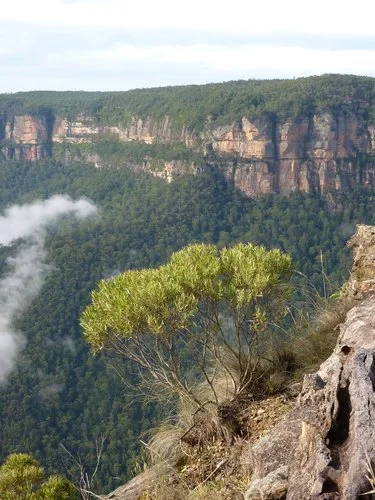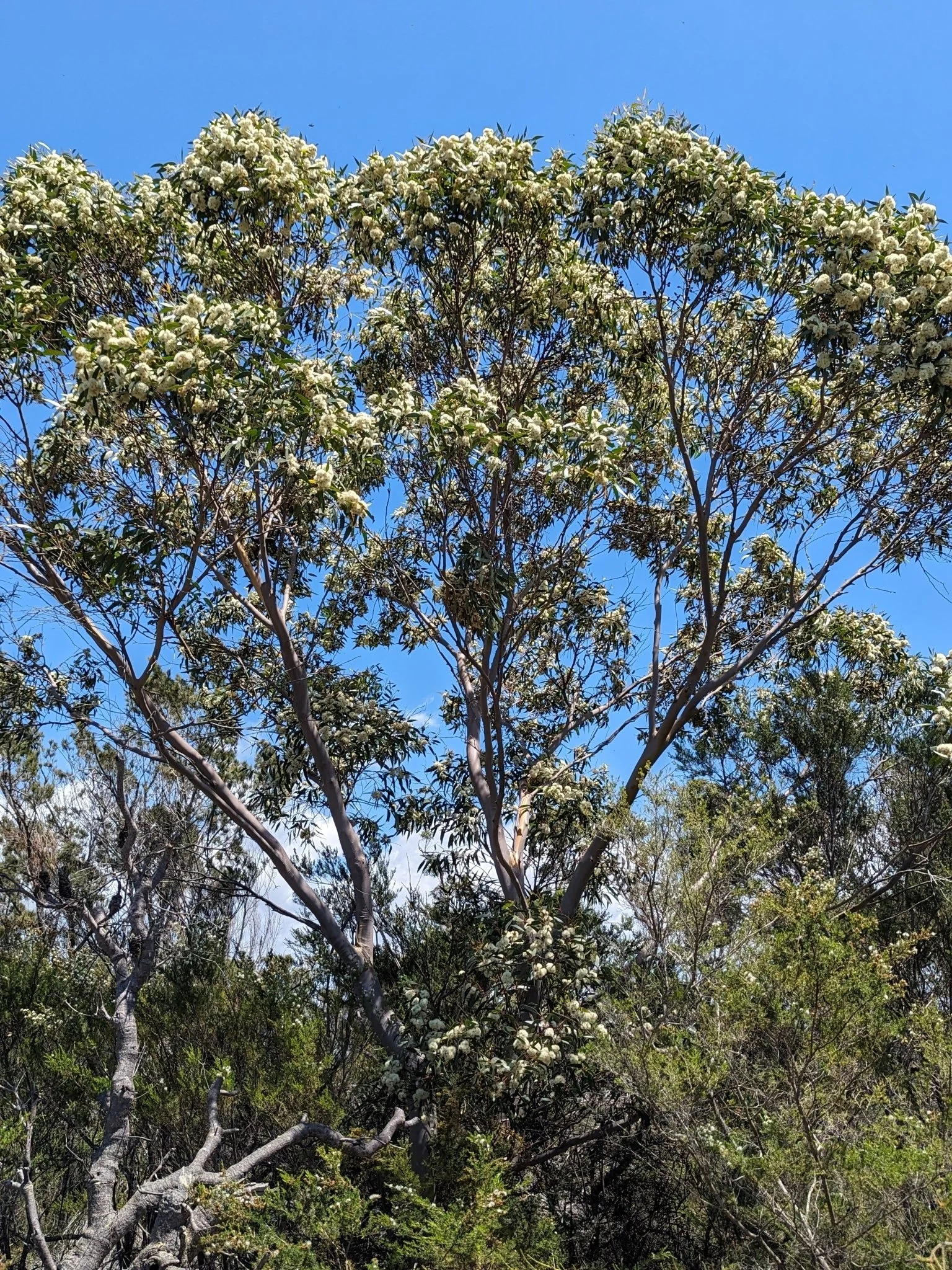Mallee Eucalyptus species of the Greater Blue Mountains
The Greater Blue Mountains Area is a Unesco World Heritage site. It consists of 1.03 million hectares of sandstone plateaus, escarpments and gorges dominated by temperate eucalypt forests. Since listed as a world heritage site in the year 2000 the Greater Blue Mountains area hosts on average 4 million visitors each year, who flock to enjoy the unique natural beauty the area has to offer.
What these tourists and locals may not know is that the Greater Blue Mountains wasn’t added to the Unesco list for it’s natural beauty alone, but in fact because the mountains showcase ‘outstanding and representative examples in a relatively small area of the evolution and adaptation of the genus Eucalyptus and eucalypt-dominated vegetation on the Australian continent.’ - In other words, we have an incredibly diverse amount of eucalyptus species due to our wide ranging of habitats. Eucalypt forests that dive into cool rainforest gullies, the mountains hold hanging swamps right next to dry scruffy heathland. Each ecological change slowly forcing the diversification of the Eucalypt genus. There are at least 99 eucalypt species in the Greater Blue Mountains area and a further 11 awaiting formal description or that fall just outside the world heritage area, bringing the total to at least 110 species.
A small subset of these Eucalyptus are our mallee species. often a smaller, multi trunked Eucalypt. This article is will be your guide to the four endemic species of mallee eucalypts you can find in the Greater Blue Mountains Area.
Eucalyptus stricta
Eucalyptus cunninghamii
Eucalyptus burgessiana
Eucalyptus apiculata
Eucalyptus stricta (Blue Mountains Mallee Ash)
(c) Dean Nicolle
What is a Mallee?
The term "mallee" refers to a variety of tree or woody plant species, primarily belonging to the Eucalyptus genus. These plants exhibit the characteristic of growing multiple stems or trunks that originate from an underground bulbous woody structure known as a lignotuber or mallee root. Typically, they reach a height of no more than 10 m. The lignotuber makes these trees incredibly tough and resilient enabling the plant to regenerate after bushfire, wind damage or other type of trauma.
It is believed that over 50% off all Eucalypt species are mallees. These slow growing and incredibly tough spices are found most commonly across southern Australia, in the states of Western Australia, South Australia, Victoria and small patches of New South Wales. They are so common that the term Mallee Woodlands and Shrublands is listed as 1 of the 33 major vegetation groups in Australia.
Where does the word Mallee Come from?
The word ‘Mallee’ is thought to originate from the word mali, meaning water, in the Wemba Wemba language, an Aboriginal Australian language of southern New South Wales and Victoria. The word is also used in the closely related Woiwurrung language and other Aboriginal languages of Victoria, South Australia, and southern New South Wales.
The Australian National Botanical Gardens says that the word ‘Mallee is an Aboriginal name for a group of eucalypts which grow to a height of 2 - 9 metres and have many stems arising from a swollen woody base known as a lignotuber.’
The Mallees endemic to the Blue Mountains are less abundant than those located in the mallee woodlands of southern Australia. There are only four species, with E. cunninghamii geographically locked to the upper Blue Mountains making it somewhat rare in the wild, but endangered by no means and protected with the world heritage listing. Eucalyptus stricta is further spread with confirmed populations as far south as the Budawang National Park. Even though Eucalyptus burgessiana’s common name is Faulconbridge mallee ash, Faulconbridge being a village in the Blue Mountains, it is actually fairly common in NSW, being found down the coast to Jervis Bay. Eucalyptus apiculata is endemic to the Central Tablelands on sandstone-derived soils from east of Rylstone south through the Wollongong region to Berrima.
Blue Mountains Mallee Plant Profiles
Eucalyptus stricta
Blue Mountains Mallee Ash
Eucalyptus Stricta, commonly known as the Blue Mountains Mallee Ash, is a small Mallee tree or mallee. This resilient plant, with a height ranging from 5 to 7 meters depending on the substrate, boasts a width of 3 to 5 meters. It forms roots system know as a lignotuber. The Blue Mountains Mallee Ash exhibits elegant small flowers on previous seasons growth in hues of white to cream. Thriving in temperate to cool-temperate climate zones, this species is somewhat versatile in its light requirements, flourishing in full sun and tolerating light shade. It proves to be hardy thriving in sandy, poor soils, with a preference for acidic to neutral pH levels. Notably frost-hardy, this plant showcases its hardiness in our tough australian climate.
Eucalyptus cunninghamii
Cliff Mallee Ash
Eucalyptus cunninghamii, commonly referred to as Cliff Mallee-ash, is a shrub to small tree Ranging from 0.5 to 2 meters in height and 1 to 4 meters in width, this species features densely held foliage atop numerous stems and roots characterized by a lignotuber. Its delicate white and green-white flowers grace the plant in recorded intervals during April, September, and December. Thriving in the natural habitat of Blue Mountains' Mallee Heath, steep slopes, and cliff edges, this resilient species is naturally restricted to cool-temperate climates on the upper Blue Mountains. It flourishes full sun and tolerates light shade, and enjoys eroded skeletal sandy soil on sandstone. Notably frost-hardy and drought tolerant.
Eucalyptus burgessiana
Faulconbridge mallee ash
The Faulconbridge Mallee Ash, scientifically known as Eucalyptus burgessiana, is a small tree with a compact mallee habit. It typically reaches a height of up to 7 meters and spans a width of 3-5 meters. The plant is characterized by a lignotuber root system. Its flowers, appearing in white, cream, and yellow hues, bloom has been recorded in various months, including May, August, September, November, and December. Thriving in temperate climates, this species prefers full sun skeletal sand on sandstone soils with an Noteworthy for its frost tolerance and drought resistance, the Faulconbridge Mallee Ash is well-suited for garden styles inspired by Australian native or Mediterranean landscapes.
Eucalyptus apiculata
Narrow-Leaved Mallee Ash
The Narrow-Leaved Mallee Ash, scientifically known as Eucalyptus apiculata, is a small tree with a compact habit as a Mallee, it typically reaches a height of 4-6 meters and spans a width of 3-4 meters. The tree produces charming flowers in shades white, cream, with recorded blooming periods in January, March, October, and December. Thriving in temperate climates, this species prefers full sun exposure and exhibits moderate frost tolerance while showcasing commendable drought resistance. The Narrow-Leaved Mallee Ash is adaptable to poor soils, particularly those comprised of sandstone.
Mallee’s In the Home Garden
If you live local to the Blue Mountains or in surrounding areas you may wish to bring some mallee magic into your home garden. They make great ornamental & productive additions to the garden our favorites are E. stricta & E. Cunninghamii as they are objectively the most attractive of our endemic mallees. Their attractive and unique habit makes them perfectly suited for Australian native and mediterranean style gardens.
These mallee’s are also tough and drought tolerant making them ideal for waterwise gardens.
They attract native birds and wildlife to your garden encouraging a healthy ecosystem to prosper around you.
They make great productive additions to the garden. Not as edible plants but as plants that can be harvested for firewood kindling. Due to their hardly nature and underground lignotuber, you cut a few branches off at the base each year they will reshoot. You can then cut the trunks into useable sizes and dry the branches for 12 months before using them as kindling in your fireplace or wood burning stove. It will be important to let them fully dry out as they contain oils which can react poorly to fire when burnt as green wood. Harvesting our mallees from wild plant populations is an offence under the NSW government National Parks and Wildlife Regulation 2019.
Our endemic mallee species are not (at this stage) readily available in nurseries, which means you may find it hard to get your hands on them but if you are lucky you and local to the area, the Blue Mountains Wild Plant Rescue nursery located in Katoomba may have them available for purchase from time to time.





